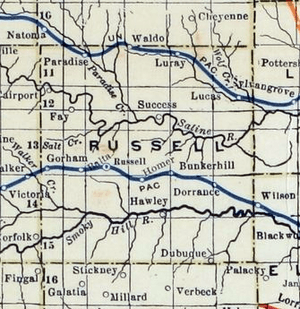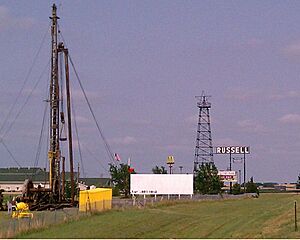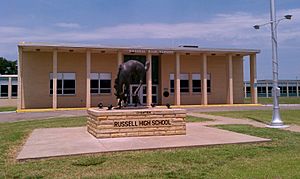Russell, Kansas facts for kids
Quick facts for kids
Russell, Kansas
|
|
|---|---|
|
City and County seat
|
|
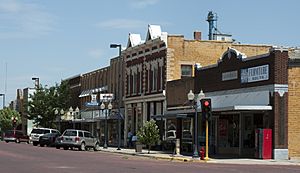
Main Street in downtown Russell (2009)
|
|
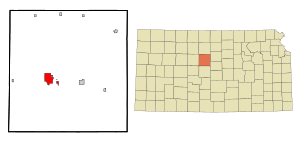
Location within Russell County and Kansas
|
|
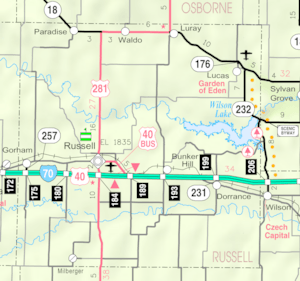
|
|
| Country | United States |
| State | Kansas |
| County | Russell |
| Founded | 1871 |
| Incorporated | 1872 |
| Named for | Russell County |
| Area | |
| • Total | 4.82 sq mi (12.47 km2) |
| • Land | 4.82 sq mi (12.47 km2) |
| • Water | 0.00 sq mi (0.00 km2) |
| Elevation | 1,828 ft (557 m) |
| Population
(2020)
|
|
| • Total | 4,401 |
| • Density | 913.1/sq mi (352.93/km2) |
| Time zone | UTC-6 (CST) |
| • Summer (DST) | UTC-5 (CDT) |
| ZIP code |
67665
|
| Area code | 785 |
| FIPS code | 20-61825 |
| GNIS ID | 475222 |
Russell is a city in Kansas, United States. It is the biggest city in and the county seat of Russell County, Kansas. This means it's the main town where the county government is located. In 2020, about 4,401 people lived there.
Contents
A Look Back: Russell's History
Russell has an interesting past! In 1865, a special mail and passenger service called the Butterfield Overland Despatch had a stop nearby. Two years later, in 1867, the Kansas Pacific Railway built its own station. This station was first called Fossil Creek, then just Fossil.
That same year, the area around it became Russell County. In 1871, people from Ripon, Wisconsin started a permanent town at Fossil Station. They decided to name it Russell after the county. The city officially became a town in 1872. After a short disagreement with a nearby town, Russell became the permanent county seat in 1874. Later, in 1876, many German families from Russia came to live in and around Russell.
In 1923, oil was found west of Russell. This led to an "oil boom" in the 1930s. Many people moved to Russell for work, and oil production became a very important part of the local economy.
Russell also became well-known in the 1990s. It was the hometown of two important politicians: Bob Dole and Arlen Specter. Both men ran for U.S. president. Bob Dole grew up in Russell and always considered it his home.
Where is Russell?
Russell is in the middle of northern Kansas. It's located where two major roads meet: Interstate 70 and U.S. Route 281. The city is about 113 miles (182 km) northwest of Wichita. It's also about 231 miles (372 km) west of Kansas City and 336 miles (541 km) east-southeast of Denver.
The city sits in an area called the Smoky Hills. This region is part of the larger Great Plains. Russell is about 5 miles (8 km) south of the Saline River and 8 miles (13 km) north of the Smoky Hill River. A small stream called Fossil Creek flows south of the city. It has a small lake, Fossil Lake, formed by a dam.
The city covers about 4.87 square miles (12.61 square kilometers) of land. There is no water area within the city limits.
Russell's Weather
Russell has a climate with hot, humid summers and cold, dry winters. This type of weather is called a humid continental climate. July is usually the hottest and wettest month. January is the coldest.
- On average, the temperature reaches or goes above 90°F (32°C) about 63 days a year.
- It reaches or goes above 100°F (38°C) about 12 days a year.
- The temperature drops below freezing (32°F or 0°C) about 130 days a year.
- The highest temperature ever recorded in Russell was 114°F (46°C) on June 30, 1980.
- The coldest temperature ever recorded was -24°F (-31°C) on December 22, 1989.
| Climate data for Russell, Kansas, 1991–2020 normals, extremes 1949–present | |||||||||||||
|---|---|---|---|---|---|---|---|---|---|---|---|---|---|
| Month | Jan | Feb | Mar | Apr | May | Jun | Jul | Aug | Sep | Oct | Nov | Dec | Year |
| Record high °F (°C) | 84 (29) |
88 (31) |
91 (33) |
101 (38) |
103 (39) |
114 (46) |
111 (44) |
109 (43) |
108 (42) |
99 (37) |
89 (32) |
79 (26) |
114 (46) |
| Mean maximum °F (°C) | 66.3 (19.1) |
72.1 (22.3) |
80.9 (27.2) |
88.0 (31.1) |
94.0 (34.4) |
101.1 (38.4) |
104.3 (40.2) |
102.2 (39.0) |
98.5 (36.9) |
90.0 (32.2) |
76.4 (24.7) |
65.1 (18.4) |
105.7 (40.9) |
| Mean daily maximum °F (°C) | 42.1 (5.6) |
46.2 (7.9) |
57.2 (14.0) |
66.6 (19.2) |
76.3 (24.6) |
87.7 (30.9) |
92.6 (33.7) |
89.7 (32.1) |
81.9 (27.7) |
69.1 (20.6) |
55.2 (12.9) |
43.3 (6.3) |
67.3 (19.6) |
| Daily mean °F (°C) | 30.5 (−0.8) |
33.9 (1.1) |
44.1 (6.7) |
53.4 (11.9) |
63.9 (17.7) |
75.1 (23.9) |
79.9 (26.6) |
77.5 (25.3) |
69.2 (20.7) |
55.9 (13.3) |
42.5 (5.8) |
32.1 (0.1) |
54.8 (12.7) |
| Mean daily minimum °F (°C) | 18.8 (−7.3) |
21.6 (−5.8) |
31.0 (−0.6) |
40.2 (4.6) |
51.5 (10.8) |
62.4 (16.9) |
67.3 (19.6) |
65.3 (18.5) |
56.6 (13.7) |
42.8 (6.0) |
29.8 (−1.2) |
20.9 (−6.2) |
42.4 (5.8) |
| Mean minimum °F (°C) | 0.6 (−17.4) |
2.9 (−16.2) |
12.4 (−10.9) |
22.8 (−5.1) |
35.9 (2.2) |
49.6 (9.8) |
56.5 (13.6) |
54.5 (12.5) |
39.9 (4.4) |
24.7 (−4.1) |
12.1 (−11.1) |
2.8 (−16.2) |
−4.9 (−20.5) |
| Record low °F (°C) | −20 (−29) |
−20 (−29) |
−16 (−27) |
11 (−12) |
25 (−4) |
37 (3) |
45 (7) |
45 (7) |
28 (−2) |
11 (−12) |
−5 (−21) |
−24 (−31) |
−24 (−31) |
| Average precipitation inches (mm) | 0.55 (14) |
0.71 (18) |
1.30 (33) |
2.17 (55) |
3.98 (101) |
3.31 (84) |
3.97 (101) |
3.28 (83) |
2.15 (55) |
1.72 (44) |
0.96 (24) |
0.74 (19) |
24.84 (631) |
| Average snowfall inches (cm) | 5.7 (14) |
3.7 (9.4) |
3.9 (9.9) |
0.6 (1.5) |
0.0 (0.0) |
0.0 (0.0) |
0.0 (0.0) |
0.0 (0.0) |
0.0 (0.0) |
0.3 (0.76) |
1.9 (4.8) |
4.1 (10) |
20.2 (50.36) |
| Average precipitation days (≥ 0.01 in) | 4.1 | 4.2 | 6.4 | 8.4 | 10.9 | 9.3 | 9.7 | 8.4 | 6.6 | 6.3 | 4.3 | 4.1 | 82.7 |
| Average snowy days (≥ 0.1 in) | 3.4 | 2.4 | 1.9 | 0.5 | 0.0 | 0.0 | 0.0 | 0.0 | 0.0 | 0.1 | 1.3 | 2.5 | 12.1 |
| Source 1: NOAA (snow/snow days 1981–2010) | |||||||||||||
| Source 2: National Weather Service | |||||||||||||
People of Russell
| Historical population | |||
|---|---|---|---|
| Census | Pop. | %± | |
| 1880 | 861 | — | |
| 1890 | 961 | 11.6% | |
| 1900 | 1,143 | 18.9% | |
| 1910 | 1,692 | 48.0% | |
| 1920 | 1,700 | 0.5% | |
| 1930 | 2,352 | 38.4% | |
| 1940 | 4,819 | 104.9% | |
| 1950 | 6,483 | 34.5% | |
| 1960 | 6,113 | −5.7% | |
| 1970 | 5,371 | −12.1% | |
| 1980 | 5,427 | 1.0% | |
| 1990 | 4,781 | −11.9% | |
| 2000 | 4,696 | −1.8% | |
| 2010 | 4,506 | −4.0% | |
| 2020 | 4,401 | −2.3% | |
| U.S. Decennial Census | |||
In 2010, Russell had 4,506 people living in 2,041 households. Most people (95.6%) were White. About 2.1% of the population was Hispanic or Latino.
The average age in Russell was 44.6 years. About 22.2% of residents were under 18 years old. About 22.3% were 65 years or older. There were slightly more females (51%) than males (49%).
The average income for a household was $32,347. For families, it was $43,834. About 21.6% of the population lived below the poverty line. This included 38.7% of those under 18.
Russell's Economy
Russell's economy mainly depends on agriculture. There are factories in the local industrial park that make wheat gluten and ethanol. Russell County is also one of the top counties in Kansas for producing petroleum (oil).
In 2012, most people over 16 were working. The main jobs were in sales and office work, management, and service industries. The biggest industries were education, healthcare, and retail. Agriculture and mining were also important.
Living in Russell is pretty affordable. The cost of living is lower than the U.S. average. In 2012, the average home value was $63,200.
Arts, Culture, and Fun in Russell
Arts and Music Scene
The Deines Cultural Center is a special art gallery downtown. It shows art from local and regional artists. It also has a permanent collection of paintings by Birger Sandzén and wood engravings by E. Hubert Deines. The center hosts concerts, lectures, and workshops. It opened in 1990 when the Deines family donated their building and art.
Ad Astra Music Festival
Every July, Russell hosts the Ad Astra Music Festival. This festival features concerts by talented student and professional musicians. They come from all over the United States and the world. The music includes classical, modern, and jazz styles. The festival started in 2015.
Events and Celebrations
Russell has many fun events throughout the year:
- The annual Russell County Free Fair happens in the last week of July. It has a 4-H livestock sale, carnival rides, live music, and more.
- Other events include the Blarney Stone Hunt, the Independence Day Freedom Fireworks Celebration, and the Bricks, Broncs & BBQ and Flatland Car & Cycle Show in October.
- In December, there's the Lighted Christmas Parade and Weihnachtsfest, a Christmas festival.
Every ten years since 1941, Russell holds a big festival called Prairiesta. It celebrates the city's founding and history. This June festival includes a parade, carnival, live music, art, and a historical show.
Places to Visit
- The Fossil Station Museum in downtown Russell shows items from Russell County's history. It's in the old sheriff's office and county jail, built in 1907 from local limestone.
- The Russell County Historical Society also takes care of two old limestone homes: the Gernon House (built 1872) and the Heym-Oliver House (built 1878).
- The Oil Patch Museum is north of I-70 Exit 184. It teaches about the area's geology and the history of oil drilling and production.
Libraries
The Russell Public Library is the city's main library. It's located downtown on West Wisconsin (6th) Street. It has over 32,000 books and other items. The library opened in 1901 and moved to its current building in 1962.
Parks and Recreation
Russell's Park Department manages seven parks. The biggest is Memorial Park, located on the east side of the city. It has baseball fields, tennis courts, a skateboard park, a play park, and a frisbee golf course. The Russell Municipal Golf Course is also there. It's a 9-hole course that opened in 1952. The city also has a public swimming pool next to Memorial Park.
Education
The public schools in Russell are part of the Russell County USD 407 school district. There are four public schools in the city:
- Russell High School (grades 9-12)
- Ruppenthal Middle School (grades 6-8)
- Bickerdyke Elementary School (grades 2-5)
- Simpson Elementary School (grades K-1)
Media and News
The Russell County News is the local newspaper. It comes out every Thursday.
Russell has three radio stations:
- KRSL (990 AM) plays classic country music.
- KRSL-FM (95.9 FM) plays classic hits.
- KCCV-FM (95.1 FM) is a Christian radio station.
Russell is also part of the Wichita-Hutchinson television market. You can watch ABC, CBS, Fox, and NBC channels in the area. Smoky Hills Public Television, the PBS station for western Kansas, is based nearby.
Getting Around Russell
Transportation
Interstate 70 and U.S. Route 40 run together just south of Russell. They cross U.S. Route 281, which goes north-south through the town.
The Russell Municipal Airport is southeast of the city. It's a public airport with two runways, used for smaller planes.
The Union Pacific Railroad has a freight train line, the Kansas Pacific (KP) Line, that runs through Russell.
Utilities and Services
The city government provides many services to its residents. These include electricity, recycling, trash removal, wastewater management, and water. Internet and cable TV are offered by Eagle Communication and Nex-Tech. Most homes use natural gas for heating, provided by Kansas Gas Service.
Famous People from Russell
Many notable people have lived in or were born in Russell:
- Philip Anschutz (born 1939), a very successful businessman
- Sue Anschutz-Rodgers (born 1936), a ranch owner and helper of good causes
- Wendall Anschutz (1938–2010), a news anchor
- Judith Barzilay (born 1944), a U.S. federal judge
- Steven Bender (1950–2010), a technology entrepreneur
- Curt Dawson (1939–1985), an actor
- Bob Dole (1923–2021), a former leader in the U.S. Senate
- Steve Doocy (born 1956), a news anchor
- Marj Dusay (1936–2020), an actress
- Paul Eggert (born 1954), a computer scientist
- Asa Kinney (1810–1886), an early settler and politician
- Jim Line (1926–2013), a college basketball player
- C.J. Mahoney (born 1977), a government official
- Larry Ochs (1924–2003), a former mayor of Colorado Springs
- Arlen Specter (1930–2012), a U.S. senator from Pennsylvania
- Walter Sutton (1877–1916), a geneticist (someone who studies genes)
- Troy Waymaster, a member of the Kansas House of Representatives
See also
 In Spanish: Russell (Kansas) para niños
In Spanish: Russell (Kansas) para niños


